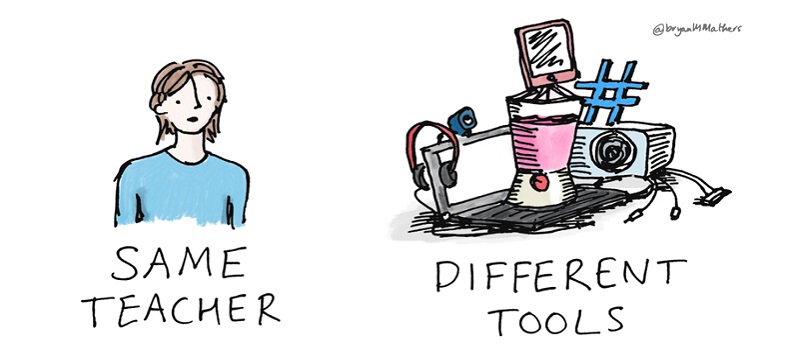References
Fiester, H. and Green, T. (2016) ‘Student use of Backchannels’, TechTrends, vol. 60, no. 4, pp. 404–408.
Gikandi, J.W. and Morrow, D. (2016) ‘Designing and implementing peer formative feedback within online learning environments’, Technology, Pedagogy and Education, vol. 25, no. 2, pp. 153–70.
Murphy, E., Rodriguez-Manzanares, M.A. and Barbour, M. (2011) ‘Asynchronous and synchronous online teaching: Perspectives of Canadian high school distance education teachers’, British Journal of Educational Technology, vol. 42, no. 4, pp. 583–91.
Price, L., Richardson, J.T.E. and Jelfs, A. (2007) ‘Face-to-face versus online tutoring support in distance education’, Studies in Higher Education, vol. 32, pp. 1–20.
Richardson, J.T.E. (2009) ‘Face-to-face versus online tutoring support in humanities courses in distance education’, Arts and Humanities in Higher Education, vol. 8, no. 1, pp. 69–85.
Ausubel, D.P. (1960) ‘Use of advance organisers in the learning and retention of meaningful material’, Journal of Educational Psychology, vol. 51, no. 5, pp. 267–72.
Beasley, J.G. and Beck, D.E. (2017) ‘Defining Differentiation in Cyber Schools: What Online Teachers Say’, TechTrends, vol. 61, no. 6, pp. 550–59.
Beetham, H. (2007) ‘An approach to learning activity design’, in: Beetham, H. and Sharpe, R. (eds) Rethinking Pedagogy for a Digital Age, Oxford, RoutledgeFalmer, pp. 26–40.
Bruner, J.S. (1966) Toward a Theory of Instruction, Cambridge, MA, Harvard University Press.
Chaos theory: https://en.wikipedia.org/wiki/Chaos_theory
Churchill, D. (2007) ‘Towards a useful classification of learning objects’, Educational Technology Research and Development, vol. 55, no. 5, pp. 479–97.
Cooper, S. (2016) 10 Best Practices To Be An Effective Online Teacher [Online]. Available at https://elearningindustry.com/10-best-practices-effective-online-teacher (Accessed 6 November 2017).
Donovan, J., Mader, C.E. and Shinsky, J. (2006) ‘Constructive student feedback: Online vs. traditional course evaluations’, Journal of Interactive Online Learning, vol. 5, no. 3, pp. 283–96.
Hill, C. (ed.) (2009) 10 Principles of Effective Online Teaching: Best Practices in Distance Education [Online]. Available at https://www.mnsu.edu/cetl/teachingwithtechnology/tech_resources_pdf/Ten%20Principles%20of%20Effective%20Online%20Teaching.pdf (Accessed 26 June 2018).
Jones, M.H. and Gallen, A-M. (2016) ‘Peer observation, feedback and reflection for development of practice in synchronous online teaching’, Innovations in Education and Teaching International, vol. 53, no. 6, pp. 616–26.
Love, C. (2015) SAMR: A model without evidence [Online]. Available at https://charlielove.org/?p=10025 (Accessed 9 November 2017).
Piaget, J. (1957) ‘The Child and Modern Physics’, Scientific American, vol. 196, no. 3, pp. 46–51.
Puentedura, R.R. (2017) A SAMR Ladder for Teacher Professional Development [Online]. Available at http://hippasus.com/blog/wp-content/uploads/2017/09/SAMRLadderForTeacherPD.pdf (Accessed 2 November 2017).
Siemens, G. (2005) ‘Connectivism: A Learning Theory for the Digital Age’, International Journal of Instructional Technology and Distance Learning, vol. 2, no. 1 [Online]. Available at http://www.itdl.org/journal/jan_05/article01.htm (Accessed 6 November 2017).
Skinner, B.F. (1968) The Technology of Teaching, New York, NY, Appleton-Century-Crofts.
Thorndike, E.L., Bregman, E.O., Tilton, J.W. and Woodyard, E. (1928) Adult Learning, New York, NY, Macmillan.
Vygotsky, L.S. (1986) Thought and Language (trans. from Russian and revised and edited by A. Kozulin), Cambridge, MA, MIT Press.
Wenger, E. (1998) Communities of Practice: learning, meaning and identity, Cambridge, Cambridge University Press.
Arbour, M., Kaspar, R.W. and Teall, A.M. (2015) ‘Strategies to Promote Cultural Competence in Distance Education’, Journal of Transcultural Nursing, vol. 26, no. 4, pp. 436–40.
Çakiroglu, Ü., Kokoç, M., Kol, E. and Turan, E. (2016) ‘Exploring Teaching Programming Online through Web Conferencing System: The Lens of Activity Theory’, Educational Technology & Society, vol. 19, no. 4, pp. 126–39.
Coughlan, T. and Perryman, L-A. (2015) ‘Are student-led Facebook groups open educational practices?’, OER15 Conference Presentation [Online]. Available at https://oro.open.ac.uk/42541/4/OER15.pdf (Accessed 17 May 2018).
Achieve (2011) Rubrics for Evaluating Open Education Resource Objects [Online]. Available at https://www.achieve.org/files/AchieveOERRubrics.pdf (Accessed 17 November 2017).
Art Beyond Sight: How to Make a Tactile Diagram (2009) Youtube video, added by artbeyondsight [Online]. Available at https://www.youtube.com/watch?v=p8P7X7KYN5w (Accessed 17 November 2017).
Ball, S. (2012) FOSS Accessibility Tools for Libraries: Step By Step Guide [Online]. Available at http://www.eifl.net/resources/foss-disability-tools-libraries-step-step-guide (Accessed 17 November 2017).
Banes, D. and Seale, J. (2002) ‘Accessibility and inclusivity in further and higher education: an overview’ in Phipps, L., Sutherland, A. and Seale, J. (eds) Access All Areas: Disability, Technology and Learning, pp. 1–5 [Online]. Available at http://www.alt.ac.uk/docs/accessallareaslow.pdf (Accessed 16 November 2017).
Devine, H., Gonzalez, A. and Hardy, M. (2011) ‘Making accessible PDF documents’, DocEng '11 Proceedings of the 11th ACM symposium on Document engineering, pp. 275–76.
Doyle, C. and Robson, K. (2002) Accessible Curricula: Good Practice for All [Online], Cardiff, University of Wales Institute. Previously available at http://www.jisctechdis.ac.uk/techdis/resources/detail/investinyou/Accessible_Curricula. No longer available but archived by the Wayback Machine at https://web.archive.org/web/20070418114542/http://www.techdis.ac.uk/resources/files/curricula.pdf (Accessed 16 November 2017).
OpenWashington (2017)
Back to previous pagePrevious
Complete our survey
